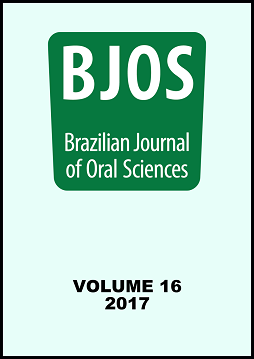Abstract
The proteins Wnts are considered a key regulator of the early development of the skeleton. Aim: The aim of this study was to evaluate the presence of the protein Wnt10b as a marker of bone repair in critical size defects surgically created in the calvaria of rabbits treated with fragmented autogenous adipose tissue graft. Methods: A total of 28 rabbits were divided into two groups: the Control group (C) and Adipose Tissue Graft group (ATG). A CSD measuring 15 mm in diameter was created in the calvaria of each animal. In rabbits of the C group, the defect was filled only with blood clot, and in ATG group, the defect was filled with fragmented adipose tissue graft. The two groups were divided into two subgroups (n = 7) for euthanasia 15 and 40 days after surgery. Histological and immunohistochemically analyses were performed to evaluate the neoformed bone and the presence/concentration of Wnt10b protein. The Kruskal-Wallis test was performed to compare the means and standard deviations of the number of Wnt10b + cells/mm2 in both groups in each postoperative period. It was assumed a significance level of 5%. Results: After 40 days, the mean concentration of the protein Wnt10b in ATG group was 26.26 (+-6.97) significant higher (p<0,001) than the mean in C group that was 305 (37.41). Conclusion: The protein Wnt10b would play a crucial role in the signaling of bone formation in bone defects treated with fragmented autogenous adipose tissue graft.References
Orciani M, Fini M, Di Primio R, Mattioli-Belmonte M. Biofabrication and Bone Tissue Regeneration: Cell Source, Approaches, and Challenges. Front Bioeng Biotechnol. 2017 Mar 23;5:17. doi: 10.3389/fbioe.2017.00017.
Xie Q, Wei W, Ruan J, Ding Y, Zhuang A, Bi X, et al. Effects of miR-146a on the osteogenesis of adipose-derived mesenchymal stem cells and bone regeneration. Sci Rep. 2017 Feb 16;7:42840. doi: 10.1038/srep42840.
Zuk PA. Human Adipose Tissue Is a Source of Multipotent Stem Cells. Mol Biol Cell. 2002 Dec;13(12):4279-95.
Im GI, Shin YW, Lee KB. Do adipose tissue-derived mesenchymal stem cells have the same osteogenic and chondrogenic potential as bone marrow derived cells? Osteoarthritis Cartilage. 2005 Oct;13(10):845-53.
Zou J, Wang G, Geng D, Zhu X, Gan M, Yang H. A Novel Cell-Based Therapy in Segmental Bone Defect: Using Adipose Derived Stromal Cells. J Surg Res. 2011 Jun 1;168(1):76-81. doi: 10.1016/j.jss.2009.07.021.
Li HX, Luo X, Liu RX, Yang YJ, Yang GS. Roles of Wnt/-catenin signaling inadipogenic differentiation potential of adipose-derived mesenchymal stem cells. Mol Cell Endocrinol. 2008 Sep 10;291(1-2):116-24. doi: 10.1016/j.mce.2008.05.005.
Bennett CN, Longo KA, Wright WS, Suva LJ, Lane TF, Hankenson KD, et al. Regulation of osteoblastogenesis and bone mass by Wnt10b. Proc Natl Acad Sci U S A. 2005 Mar 1;102(9):3324-9.
Logan CY, Nusse R. The Wnt signaling pathway in development and disease. Annu Rev Cell Dev Biol. 2004;20:781-810.
Glass DA, Bialek P, Ahn JD, Starbuck M, Patel MS, Clevers H, et al. Canonical wnt signaling in differentiated osteoblasts controls osteoclast differentiation. Dev Cell. 2005 May;8(5):751-64.
Hill TP, Spater D, Taketo MM, Birchmeier W, C. Hartmann C. Canonical Wnt/beta-catenin signaling prevents osteoblasts from differentiating into chondrocytes. Dev Cell. 2005 May;8(5):727-38.
Prestwich TC, Macdougald OA. Wnt/β-catenin signaling in adipogenesis and metabolism. Curr Opin Cell Biol. 2007 Dec;19(6):612-7.
Endo Y, Wolf V, Muraiso K, Kamijo K, Soon L, Uren A, et al. Wnt-3a-dependent cell motility involves RhoA activation and is specifically regulated by dishevelled-2. J Biol Chem. 2005 Jan 7;280(1):777-86.
Niehrs C. The complex world of WNT receptor signalling. Nat Rev Mol Cell Biol. 2012 Dec;13(12):767-79. doi: 10.1038/nrm3470.
Oliveira LD, Giovanini AF, Abuabara A, Klug LG, Gonzaga CC, Zielak JC, et al. Fragmented adipose tissue graft for bone healing: histological and histometric study in rabbits' calvaria. Med Oral Patol Oral Cir Bucal. 2013 May 1;18(3):e510-5.
Leucht P, Jiang J, Cheng D, Liu B, Dhamdhere G, Fang MY, et al. Wnt3a reestablishes osteogenic capacity to bone grafts from aged animals. J Bone Joint Surg Am. 2013 Jul 17;95(14):1278-88. doi: 10.2106/JBJS.L.01502.
Maiti SK, Ninu AR, Sangeetha P, Mathew DD, Tamilmahan P, Kritaniya D, et al. Mesenchymal stem cells-seeded bio-ceramic construct for bone regeneration in large critical-size bone defect in rabbit. J Stem Cells Regen Med. 2016 Nov 29;12(2):87-99.
Sterodimas A, de Faria J, Nicaretta B, Pitanguy I. Tissue engineering with adipose- derived stem cells (ADSCs): current and future applications. J Plast Reconstr Aesthet Surg. 2010 Nov;63(11):1886-92. doi: 10.1016/j.bjps.2009.10.028.
Trofin EA, Monsarrat P, Kémoun P. Cell therapy of periodontium: from animal to human? Front Physiol. 2013 Nov 15;4:325. doi: 10.3389/fphys.2013.00325.
Gomes SP, Deliberador TM, Gonzaga CC, Klug LG, Oliveira LC, Urban CD, et al. Bone healing in critical-size defects treated with immediate transplant of fragmented autogenous white adipose tissue. J Craniofac Surg. 2012 Sep;23(5):1239-44.
Gomillion CT, Burg KJL. Stem cells and adipose tissue engineering. Biomaterials. 2006 Dec;27(36):6052-63.
Longo KA, Wright WS, Kang S, Gerin I, Chiang SH, Lucas PC, et al. Wnt10b inhibits development of white and brown adipose tissues. J Biol Chem. 2004 Aug 20;279(34):35503-9.
Gimble J, Guilak F. Adipose-derived adult stem cells: isolation, characterization, and differentiation potential. Cytotherapy. 2003;5(5):362-9.
Song L, Tuan RS. Transdifferentiation potential of human mesenchymal stem cells derived from bone marrow. FASEB J. 2004 Jun;18(9):980-2.
The Brazilian Journal of Oral Sciences uses the Creative Commons license (CC), thus preserving the integrity of the articles in an open access environment.


